[English] 日本語
 Yorodumi
Yorodumi- PDB-7lck: PF 06882961 bound to the glucagon-like peptide-1 receptor (GLP-1R) -
+ Open data
Open data
- Basic information
Basic information
| Entry | Database: PDB / ID: 7lck | |||||||||||||||||||||||||||||||||||||||||||||||||||||||||||||||||||||||||||||||||||||||||||||
|---|---|---|---|---|---|---|---|---|---|---|---|---|---|---|---|---|---|---|---|---|---|---|---|---|---|---|---|---|---|---|---|---|---|---|---|---|---|---|---|---|---|---|---|---|---|---|---|---|---|---|---|---|---|---|---|---|---|---|---|---|---|---|---|---|---|---|---|---|---|---|---|---|---|---|---|---|---|---|---|---|---|---|---|---|---|---|---|---|---|---|---|---|---|---|
| Title | PF 06882961 bound to the glucagon-like peptide-1 receptor (GLP-1R) | |||||||||||||||||||||||||||||||||||||||||||||||||||||||||||||||||||||||||||||||||||||||||||||
 Components Components | Glucagon-like peptide 1 receptor | |||||||||||||||||||||||||||||||||||||||||||||||||||||||||||||||||||||||||||||||||||||||||||||
 Keywords Keywords | MEMBRANE PROTEIN / GPCR / small molecule agonist | |||||||||||||||||||||||||||||||||||||||||||||||||||||||||||||||||||||||||||||||||||||||||||||
| Function / homology |  Function and homology information Function and homology informationglucagon-like peptide 1 receptor activity / glucagon receptor activity / positive regulation of blood pressure / hormone secretion / post-translational protein targeting to membrane, translocation / response to psychosocial stress / regulation of heart contraction / peptide hormone binding / activation of adenylate cyclase activity / negative regulation of blood pressure ...glucagon-like peptide 1 receptor activity / glucagon receptor activity / positive regulation of blood pressure / hormone secretion / post-translational protein targeting to membrane, translocation / response to psychosocial stress / regulation of heart contraction / peptide hormone binding / activation of adenylate cyclase activity / negative regulation of blood pressure / adenylate cyclase-activating G protein-coupled receptor signaling pathway / Glucagon-type ligand receptors / Glucagon-like Peptide-1 (GLP1) regulates insulin secretion / transmembrane signaling receptor activity / positive regulation of cytosolic calcium ion concentration / G alpha (s) signalling events / learning or memory / cell surface receptor signaling pathway / membrane / plasma membrane Similarity search - Function | |||||||||||||||||||||||||||||||||||||||||||||||||||||||||||||||||||||||||||||||||||||||||||||
| Biological species |  Homo sapiens (human) Homo sapiens (human) | |||||||||||||||||||||||||||||||||||||||||||||||||||||||||||||||||||||||||||||||||||||||||||||
| Method | ELECTRON MICROSCOPY / single particle reconstruction / cryo EM / Resolution: 3.24 Å | |||||||||||||||||||||||||||||||||||||||||||||||||||||||||||||||||||||||||||||||||||||||||||||
 Authors Authors | Belousoff, M.J. / Johnson, R.M. / Drulyte, I. / Yu, L. / Kotecha, A. / Danev, R. / Wootten, D. / Zhang, X. / Sexton, P.M. | |||||||||||||||||||||||||||||||||||||||||||||||||||||||||||||||||||||||||||||||||||||||||||||
| Funding support |  Australia, Australia,  Japan, 5items Japan, 5items
| |||||||||||||||||||||||||||||||||||||||||||||||||||||||||||||||||||||||||||||||||||||||||||||
 Citation Citation |  Journal: Structure / Year: 2021 Journal: Structure / Year: 2021Title: Evolving cryo-EM structural approaches for GPCR drug discovery. Authors: Xin Zhang / Rachel M Johnson / Ieva Drulyte / Lingbo Yu / Abhay Kotecha / Radostin Danev / Denise Wootten / Patrick M Sexton / Matthew J Belousoff /    Abstract: G protein-coupled receptors (GPCRs) are the largest class of cell surface drug targets. Advances in stabilization of GPCR:transducer complexes, together with improvements in cryoelectron microscopy ...G protein-coupled receptors (GPCRs) are the largest class of cell surface drug targets. Advances in stabilization of GPCR:transducer complexes, together with improvements in cryoelectron microscopy (cryo-EM) have recently been applied to structure-assisted drug design for GPCR agonists. Nonetheless, limitations in the commercial application of these approaches, including the use of nanobody 35 (Nb35) to aid complex stabilization and the high cost of 300 kV imaging, have restricted broad application of cryo-EM in drug discovery. Here, using the PF 06882961-bound GLP-1R as exemplar, we validated the formation of stable complexes with a modified Gs protein in the absence of Nb35. In parallel, we compare 200 versus 300 kV image acquisition using a Falcon 4 or K3 direct electron detector. Moreover, the 200 kV Glacios-Falcon 4 yielded a 3.2 Å map with clear density for bound drug and multiple structurally ordered waters. Our work paves the way for broader commercial application of cryo-EM for GPCR drug discovery. | |||||||||||||||||||||||||||||||||||||||||||||||||||||||||||||||||||||||||||||||||||||||||||||
| History |
|
- Structure visualization
Structure visualization
| Movie |
 Movie viewer Movie viewer |
|---|---|
| Structure viewer | Molecule:  Molmil Molmil Jmol/JSmol Jmol/JSmol |
- Downloads & links
Downloads & links
- Download
Download
| PDBx/mmCIF format |  7lck.cif.gz 7lck.cif.gz | 88.6 KB | Display |  PDBx/mmCIF format PDBx/mmCIF format |
|---|---|---|---|---|
| PDB format |  pdb7lck.ent.gz pdb7lck.ent.gz | 63 KB | Display |  PDB format PDB format |
| PDBx/mmJSON format |  7lck.json.gz 7lck.json.gz | Tree view |  PDBx/mmJSON format PDBx/mmJSON format | |
| Others |  Other downloads Other downloads |
-Validation report
| Summary document |  7lck_validation.pdf.gz 7lck_validation.pdf.gz | 1 MB | Display |  wwPDB validaton report wwPDB validaton report |
|---|---|---|---|---|
| Full document |  7lck_full_validation.pdf.gz 7lck_full_validation.pdf.gz | 1 MB | Display | |
| Data in XML |  7lck_validation.xml.gz 7lck_validation.xml.gz | 28 KB | Display | |
| Data in CIF |  7lck_validation.cif.gz 7lck_validation.cif.gz | 40.1 KB | Display | |
| Arichive directory |  https://data.pdbj.org/pub/pdb/validation_reports/lc/7lck https://data.pdbj.org/pub/pdb/validation_reports/lc/7lck ftp://data.pdbj.org/pub/pdb/validation_reports/lc/7lck ftp://data.pdbj.org/pub/pdb/validation_reports/lc/7lck | HTTPS FTP |
-Related structure data
| Related structure data |  23276MC  7lciC  7lcjC C: citing same article ( M: map data used to model this data |
|---|---|
| Similar structure data |
- Links
Links
- Assembly
Assembly
| Deposited unit | 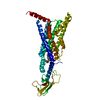
|
|---|---|
| 1 |
|
- Components
Components
| #1: Protein | Mass: 56748.418 Da / Num. of mol.: 1 Source method: isolated from a genetically manipulated source Source: (gene. exp.)  Homo sapiens (human) / Gene: GLP1R / Production host: Homo sapiens (human) / Gene: GLP1R / Production host:  Trichoplusia ni (cabbage looper) / References: UniProt: P43220 Trichoplusia ni (cabbage looper) / References: UniProt: P43220 |
|---|---|
| #2: Chemical | ChemComp-UK4 / |
| #3: Water | ChemComp-HOH / |
| Has ligand of interest | Y |
| Has protein modification | Y |
-Experimental details
-Experiment
| Experiment | Method: ELECTRON MICROSCOPY |
|---|---|
| EM experiment | Aggregation state: PARTICLE / 3D reconstruction method: single particle reconstruction |
- Sample preparation
Sample preparation
| Component | Name: GLP-1:Gs complex with small molecule agonist (PF-06882961) bound Type: COMPLEX / Entity ID: #1 / Source: RECOMBINANT |
|---|---|
| Molecular weight | Experimental value: NO |
| Source (natural) | Organism:  Homo sapiens (human) Homo sapiens (human) |
| Source (recombinant) | Organism:  Trichoplusia ni (cabbage looper) Trichoplusia ni (cabbage looper) |
| Buffer solution | pH: 7.4 |
| Specimen | Conc.: 5 mg/ml / Embedding applied: NO / Shadowing applied: NO / Staining applied: NO / Vitrification applied: YES |
| Vitrification | Cryogen name: ETHANE |
- Electron microscopy imaging
Electron microscopy imaging
| Microscopy | Model: TFS GLACIOS |
|---|---|
| Electron gun | Electron source:  FIELD EMISSION GUN / Accelerating voltage: 200 kV / Illumination mode: FLOOD BEAM FIELD EMISSION GUN / Accelerating voltage: 200 kV / Illumination mode: FLOOD BEAM |
| Electron lens | Mode: BRIGHT FIELD |
| Image recording | Electron dose: 55.8 e/Å2 / Film or detector model: FEI FALCON IV (4k x 4k) |
- Processing
Processing
| Software | Name: PHENIX / Version: 1.18.2_3874: / Classification: refinement | ||||||||||||||||||||||||
|---|---|---|---|---|---|---|---|---|---|---|---|---|---|---|---|---|---|---|---|---|---|---|---|---|---|
| EM software | Name: PHENIX / Category: model refinement | ||||||||||||||||||||||||
| CTF correction | Type: PHASE FLIPPING AND AMPLITUDE CORRECTION | ||||||||||||||||||||||||
| Symmetry | Point symmetry: C1 (asymmetric) | ||||||||||||||||||||||||
| 3D reconstruction | Resolution: 3.24 Å / Resolution method: FSC 0.143 CUT-OFF / Num. of particles: 632000 / Symmetry type: POINT | ||||||||||||||||||||||||
| Refine LS restraints |
|
 Movie
Movie Controller
Controller





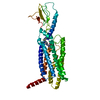


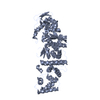

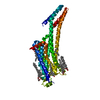

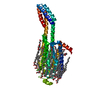
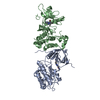
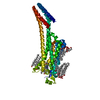
 PDBj
PDBj





